Four questions Pa. needs to answer to avert election chaos in 2020
Pick an issue, any issue. Environmental health? Fiscal conservatism? Probation reform?

Montgomery County voters will using a new voting system this year. Paper ballots will be filled out and then fed into a scanning machine where they will be read and stored. (Courtesy of Montgomery County)
This article originally appeared on PA Post.
–
Pick an issue, any issue.
Environmental health? Fiscal conservatism? Probation reform?
You’re limited in your ability to influence how elected officials handle “your issue” — or anything else – if our voting systems aren’t secure and reliable.
That’s why I’ve spent the past four months or so covering election security in Pennsylvania. Closely.
So far, my attention has largely been on the replacement of voting machines throughout the state.
That’s meant plenty of travel to observe and document different voting machine configurations at voter demonstrations in more than half a dozen counties. I’ve read, at this point, more than hundreds, maybe thousands, of pages of voting machine contracts and technical documents — not to mention filing the Right-to-Know requests required, in most cases, to obtain them.
I’ve also sat through poll worker trainings and covered everything from local controversies to the first test-run of new election auditing procedures that ultimately will be in place statewide.
And there will be more to come in 2020.
Let’s focus on four key questions that need to be resolved if Pennsylvania hopes to avert problems at the polls in a key election year:
Q: Philadelphia, Northampton and Cumberland counties (home to nearly 1 in 5 Pa. voters) plan to use the ExpressVote XL device in 2020. Will the courts step in to block its use?
A: We probably won’t find out for at least another month.
Two lawsuits – one state and one federal – are trying to get the ExpressVote XL decertified.

U.S. District Judge Paul Diamond has set a Jan. 21 court date in the federal case, which began as a recount attempt by former Green Party presidential candidate Jill Stein in the wake of the 2016 election. When the plaintiffs and the state reached a settlement, their agreement specified how Pa. would update its voting machines and otherwise improve election security.
Claiming the XL doesn’t meet the requirements set forth in the settlement, Stein’s lawyers petitioned to reopen the case just before Thanksgiving this year.
The other case was filed in Commonwealth Court just a couple weeks ago. Some of the plaintiffs bringing this case previously tried to get the XL decertified by petitioning the Pa. Department of State.
Officials in Philadelphia and Cumberland counties say if either lawsuit challenging the XL prevails, it would be impossible to get new machines in place for the city’s 1.5 million voters before the 2020 primary.
Meanwhile, the XL is still among the voting systems under consideration in Dauphin County, where commissioners will convene for a special session Dec. 30, one day before the year-end deadline. The commissioners say the XL most resembles the voting system used there now, but they’re hesitant to go forward given the two court cases challenging the system’s use.
And then there are the problems with the XL during November’s municipal elections.
Half of Pa.’s counties rolled out new voting systems for the Nov. 5 election. No election goes off without a hitch, and issues arose in most jurisdictions involving multiple voting systems (and in many, straightforward fixes were readily apparent).
But the most dramatic problems occurred in Northampton County, where brand new XL machines incorrectly tallied votes for some races with cross-filed candidates. The errors prompted a manual recount. It took all night, and some officials say that proves the paper backup system actually works.
Northampton voters also complained the machines registered votes they hadn’t cast.
Manufacturer Election Security and Software took the blame for all of it, but says a software update should fix the incorrect votes being registered — a problem that was tied to the touchscreen’s hypersensitivity (and was also reported in Philly). To ensure thorough pre-election logic and accuracy testing, the state will oversee the process in Northampton.
Still, Northampton’s election commission passed a “vote of no confidence” in the machine and manufacturer at its final meeting of the year.
Q: The XL isn’t used in my county, so why should I care?
A: The majority of voters in Pennsylvania and the rest of the country will use a system from ES&S next year. By the company’s own admission, the problems in Northampton County were the result of its own lapses in basic protocol.
The company says it will improve quality control measures at its warehouse and ensure the correct instructions are provided to county elections workers responsible for pre-election testing.
If either of the court cases succeeds in forcing the decertification of the XL, it doesn’t appear other machines made by ES&L would be affected. But we also don’t yet know what will come out in court about how the XL works and, if it gets decertified, whether other systems share the features that could also get them decertified.
In short, anyone living in a county using an ES&S machine should be paying attention.
Q: How is Pa. paying for the new voting machines?
A: We have a plan, but not (all) the cash in hand.
Even though a few Pa. counties have yet to finalize their agreements for new machines, statewide costs have already exceeded the $150 million maximum estimated previously.
The state has pledged to reimburse counties up to 60 percent of their expenses – but doesn’t have the funding in hand yet.
As county commissioners across the state negotiated the dense, highly technical contracts, their state counterparts gridlocked earlier this year over how to fund their share of costs.
Ultimately, the GOP legislature and Democratic governor agreed that the Pennsylvania Economic Development Financing Authority will issue $90 million in bonds (after settling debate over the legality of incurring the debt). PEDFA’s board didn’t discuss the bond deal at its last meeting in December; its next is Jan. 15.
Q: The state law that authorized the PEDFA bonds also overhauled the commonwealth’s election code to an extent unprecedented since its adoption in 1937. How will counties deal with the reforms?
A: The changes will almost certainly create more work for local elections officials, but counties aren’t getting much extra help from the state.
The changes include the end of straight-party voting, the inception of no-excuse absentee voting, an extended voter registration deadline and a reduced ballot-printing requirement.
Most provisions of Act 77 will be effective by the spring primary, setting the stage for chaos during an already-hectic time, critics say.
One issue: The law doesn’t include the extra money election officials say they’ll probably need to implement the new rules. That includes hiring people to process voter registrations, a turnaround time that’s been cut to two weeks from a month by the new law. Local officials say they’ll also need more bodies, additional/higher capacity scanners, or both to handle the higher number of mailed paper ballots expected now that anyone can vote absentee (versus the previous system under which absentee ballots were limited to those with a medical, work-related or otherwise pressing/unavoidable excuse).
Plus, voters will still be adjusting to new machines, a different method of voting or both.
Pa. started the year out as one of just a dozen states where most jurisdictions still used touchscreen direct recording electronic devices, or DREs; as of now, hand-marked ballot systems dominate.
And even though the majority of counties have already launched their systems, most voters didn’t turnout for the off-year municipal elections. So those machines will still be a new experience for many people voting in 2020.
The Department of State has pledged to give guidance to counties on how to deal with all the changes. At last check, there wasn’t a timetable available, but DoS officials have been “extremely busy” working on it, according to spokeswoman Wanda Murren.
WHYY is your source for fact-based, in-depth journalism and information. As a nonprofit organization, we rely on financial support from readers like you. Please give today.






